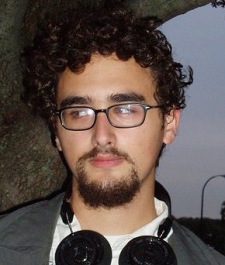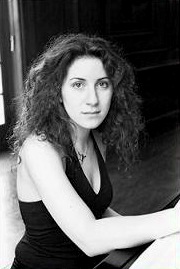Our regular listen to and look at living, breathing composers and performers that you may not know yet, but I know you should… And can, right here and now, since they’re nice enough to offer so much good listening online:
Beth Custer (b. 1958 — US)
 Extra, extra!… Fearless woman seizes her day!…
Extra, extra!… Fearless woman seizes her day!…
Beth was born in South Bend, Indiana, raised in western New York, but has lived in San Francisco for for the last twenty-five-and-some years.
As if she wasn’t busy enough being a composer, performer, bandleader, clarinet teacher, and running a record label, she’s also a founding member of the notorious silent film soundtrack purveyors the Club Foot Orchestra, 4th-world ambient ensemble Trance Mission, the quintet of esteemed clarinetists Clarinet Thing, the trip-hop duo Eighty Mile Beach, and the Latin-jazz-rock influenced Doña Luz 30 Besos. She now leads The Beth Custer Ensemble (including long time collaborator Jan Jackson on drums, guitarist David James, iconic pianist Graham Connah, and New Yorker transplant bassist Mark Calderon).
Beth composes for film, television, installations and the concert stage (hall or club are both fair game). Recent commissions include A Trip Down Market Street 1905/2005, a live outdoor cinema event by Melinda Stone produced by the Exploratorium; The Ballad of Pancho & Lucy musical for Campo Santo Theatre; and Bernal Heights Suite for the Left Coast Chamber Ensemble.
As the above might indicate, Beth’s music and monster clarinet chops are put in service of everything from the primal to the rarest air. Though seekers of the plain-and-pretty might have a hard time, the rest of us can enjoy a bit of all this at her extremely spiffy website, chockablock-full of MP3s, video, interviews and other info.
 I first ran across this fine pianist a few years ago, while searching the web for information about Marcel Duchamp’s prescient, chance-based 1913 “compositions”,
I first ran across this fine pianist a few years ago, while searching the web for information about Marcel Duchamp’s prescient, chance-based 1913 “compositions”,  Born in Boston and a product of Berklee, the New England Conservatory and Bard, Amos now makes his home in Tel Aviv. He was one of the brave few “serious” composers that took the online plunge early; I first bumped into him and his music way back in 1999 or 2000 on the old MP3.com. His work has a touch of the modern Romantic, chromatic and sharp, though the lyrical is never too far away.
Born in Boston and a product of Berklee, the New England Conservatory and Bard, Amos now makes his home in Tel Aviv. He was one of the brave few “serious” composers that took the online plunge early; I first bumped into him and his music way back in 1999 or 2000 on the old MP3.com. His work has a touch of the modern Romantic, chromatic and sharp, though the lyrical is never too far away.
 I don’t know very much about Aitana, except that she teaches composition at the Catholic University in Buenos Aires, and did some study in Europe with Walter Zimmermann.
I don’t know very much about Aitana, except that she teaches composition at the Catholic University in Buenos Aires, and did some study in Europe with Walter Zimmermann. Susan plays a quintessential Texas instrument, the pedal steel guitar. She spent a lot of years paying her dues and perfecting her technique in Country bands, but some part of her always hankered after things more adventurous. I’ll let her pick up the story:
Susan plays a quintessential Texas instrument, the pedal steel guitar. She spent a lot of years paying her dues and perfecting her technique in Country bands, but some part of her always hankered after things more adventurous. I’ll let her pick up the story:
 Urban Sax is a long-running ensemble / musical extravaganza founded by the French musician Gilbert Artman. It was was formed in 1973, when Artman organized a concert by a group of eight saxophonists at a classical music festival in the south of France. In subsequent years, the number of players grew to 12, 20, 30, and by now consists of 52 musicians (with saxophones ranging from the soprano to bass registers). Artman frequently integrates local musicians and dancers into his performances, and thus the ensemble can encompass as many as 200 performers.
Urban Sax is a long-running ensemble / musical extravaganza founded by the French musician Gilbert Artman. It was was formed in 1973, when Artman organized a concert by a group of eight saxophonists at a classical music festival in the south of France. In subsequent years, the number of players grew to 12, 20, 30, and by now consists of 52 musicians (with saxophones ranging from the soprano to bass registers). Artman frequently integrates local musicians and dancers into his performances, and thus the ensemble can encompass as many as 200 performers. I started composing when I was 11, on a family trip to Italy. My earliest influence was Bach, and after that, Hindemith, Prokofiev and Bartók. When I was 15 I discovered rock (by means of “Strawberry Fields Forever” and “I Am The Walrus”), and when I was 17 I discovered the experimental rock underground (by means of The Olivia Tremor Control, Kukl, Mr. Bungle and Thinking Plague). Those two discoveries got me interested in combining ideas from the scored-music world and ideas from the rock world, and since then I’ve been exploring various ways of bringing disparate materials together — not just rock and scored music, but really anything. I got my BA at Yale in 2005, and am currently working towards my MA at the University of Michigan, where I’m studying with Erik Santos.
I started composing when I was 11, on a family trip to Italy. My earliest influence was Bach, and after that, Hindemith, Prokofiev and Bartók. When I was 15 I discovered rock (by means of “Strawberry Fields Forever” and “I Am The Walrus”), and when I was 17 I discovered the experimental rock underground (by means of The Olivia Tremor Control, Kukl, Mr. Bungle and Thinking Plague). Those two discoveries got me interested in combining ideas from the scored-music world and ideas from the rock world, and since then I’ve been exploring various ways of bringing disparate materials together — not just rock and scored music, but really anything. I got my BA at Yale in 2005, and am currently working towards my MA at the University of Michigan, where I’m studying with Erik Santos. Lainie and Alex were at Yale together, and they share a lot of the same anything-goes spirit. She received her BA in music from Yale in 2004, studying with John Halle, Matthew Suttor, and Kathryn Alexander. She also snagged a second BA in Near-Eastern languages and civilizations, specializing in the religious chant traditions of the middle east. She studied Torah cantillation with Rebecca Boggs and Quranic chanting with Dr. Abd al Hamid. If I’ve got it right, she’s currently teaching at St. Ann’s School in Brooklyn.
Lainie and Alex were at Yale together, and they share a lot of the same anything-goes spirit. She received her BA in music from Yale in 2004, studying with John Halle, Matthew Suttor, and Kathryn Alexander. She also snagged a second BA in Near-Eastern languages and civilizations, specializing in the religious chant traditions of the middle east. She studied Torah cantillation with Rebecca Boggs and Quranic chanting with Dr. Abd al Hamid. If I’ve got it right, she’s currently teaching at St. Ann’s School in Brooklyn.